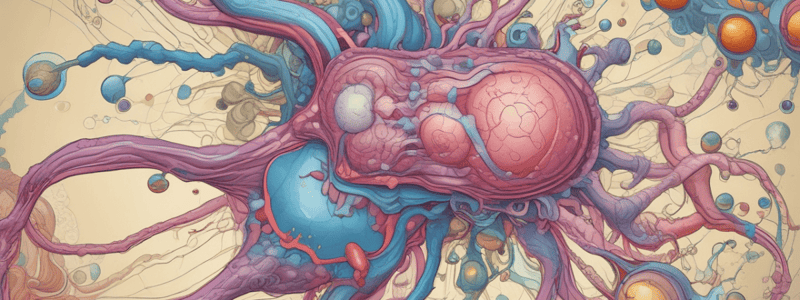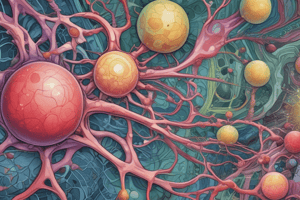Podcast
Questions and Answers
What is the function of the smooth endoplasmic reticulum in relation to proteins?
What is the function of the smooth endoplasmic reticulum in relation to proteins?
- Formation of Cys-Cys bridges
- Translation of mRNA
- Targeting proteins to the correct location in the cell
- Biosynthesis of membrane lipids and steroids (correct)
Which organelle is responsible for the assembly of proteins?
Which organelle is responsible for the assembly of proteins?
- Rough endoplasmic reticulum
- Golgi apparatus
- Ribosome (correct)
- Smooth endoplasmic reticulum
What is the function of the Golgi apparatus in relation to proteins?
What is the function of the Golgi apparatus in relation to proteins?
- Biosynthesis of membrane lipids and steroids
- Formation of Cys-Cys bridges
- Translation of mRNA
- Directing proteins to their correct location in the cell (correct)
What is the function of the rough endoplasmic reticulum in relation to proteins?
What is the function of the rough endoplasmic reticulum in relation to proteins?
What is the site of N-linked glycosylation modifications?
What is the site of N-linked glycosylation modifications?
What is the function of the ribosome in relation to mRNA?
What is the function of the ribosome in relation to mRNA?
What is the function of the smooth endoplasmic reticulum in relation to xenobiotics?
What is the function of the smooth endoplasmic reticulum in relation to xenobiotics?
What is the site of the formation of Cys-Cys bridges?
What is the site of the formation of Cys-Cys bridges?
What is the primary function of secretory vesicles?
What is the primary function of secretory vesicles?
Which organelle has a pH of around 5.0 and is involved in autophagy?
Which organelle has a pH of around 5.0 and is involved in autophagy?
What is the function of the extracellular matrix?
What is the function of the extracellular matrix?
What is the characteristic feature of a prokaryote?
What is the characteristic feature of a prokaryote?
Which organelle is involved in the detoxification of harmful substances?
Which organelle is involved in the detoxification of harmful substances?
What is the function of cilia?
What is the function of cilia?
Which organelle is involved in the synthesis of plasmalogens?
Which organelle is involved in the synthesis of plasmalogens?
What is the primary function of lysosomes?
What is the primary function of lysosomes?
What is the main difference between a cell and an organelle?
What is the main difference between a cell and an organelle?
What is the functional unit of a tissue?
What is the functional unit of a tissue?
What is the maximum size of a cell?
What is the maximum size of a cell?
What is the term for an organized assembly of cells and their extracellular products?
What is the term for an organized assembly of cells and their extracellular products?
What is the definition of an organelle?
What is the definition of an organelle?
What is the term for a diffuse functional network of cells situated in many parts of the body?
What is the term for a diffuse functional network of cells situated in many parts of the body?
What is the volume of an erythrocyte?
What is the volume of an erythrocyte?
What is the term for a semi-independent living unit within the body?
What is the term for a semi-independent living unit within the body?
What is the primary limitation of size in cells?
What is the primary limitation of size in cells?
What is the primary function of the cytoskeleton in cells?
What is the primary function of the cytoskeleton in cells?
What is the minimum resolvable size without the aid of a microscope?
What is the minimum resolvable size without the aid of a microscope?
What is the primary function of the nucleus in animal cells?
What is the primary function of the nucleus in animal cells?
What is the primary function of the nuclear envelope in animal cells?
What is the primary function of the nuclear envelope in animal cells?
What is the primary function of mitochondria in animal cells?
What is the primary function of mitochondria in animal cells?
What is the primary function of the cytosol in animal cells?
What is the primary function of the cytosol in animal cells?
What is the primary function of the plasma membrane in animal cells?
What is the primary function of the plasma membrane in animal cells?
What is the primary function of the nucleolus in animal cells?
What is the primary function of the nucleolus in animal cells?
What is the primary function of gap junctions in animal cells?
What is the primary function of gap junctions in animal cells?
Which of the following characteristics is unique to eukaryotic cells?
Which of the following characteristics is unique to eukaryotic cells?
Which of the following organelles is not present in prokaryotic cells?
Which of the following organelles is not present in prokaryotic cells?
What is the primary function of viruses?
What is the primary function of viruses?
Which of the following is a characteristic of prokaryotic cells?
Which of the following is a characteristic of prokaryotic cells?
What is the primary function of the Golgi apparatus in eukaryotic cells?
What is the primary function of the Golgi apparatus in eukaryotic cells?
Which of the following is a characteristic of eukaryotic cells?
Which of the following is a characteristic of eukaryotic cells?
Which of the following organelles is present in both prokaryotic and eukaryotic cells?
Which of the following organelles is present in both prokaryotic and eukaryotic cells?
What is the primary function of histones in eukaryotic cells?
What is the primary function of histones in eukaryotic cells?
Flashcards are hidden until you start studying
Study Notes
Cell Biology Definitions
- A cell is a semi-independent, living unit within the body that consists of an aqueous solution of organic molecules surrounded by a membrane.
- An organelle is a subunit within a cell with a defined structure and specific functions, some of which are bounded by membranes.
- A tissue is an organized assembly of cells and their extracellular products that carry out similar and coordinated activities within the body.
- An organ is an assembly of tissues coordinated to perform specific functions within the body.
- A system is an assembly of organs with specific, related activities, sharing regulatory influences.
Cell Size and Limitations
- Cells have a maximum size, with a normal range of volume between 1,000-5,000 µm3.
- Exceptions to this range include erythrocytes (100 µm3) and oocytes (4,000,000 µm3).
- The size of cells is limited by the rate of diffusion, including the movement of metabolites, uptake of oxygen, and movement of mRNA and vesicles.
- Diffusion is less efficient at distances greater than 50µm.
- Solutions to these problems include the use of cytoskeleton to actively move things around cells, creating "giant" cells with multiple nuclei, and gap junctions between cells for efficient movement of metabolites.
Visualizing Cells and Organelles
- Light microscopes have a limited ability to visualize components of cells, only resolving the nucleus and plasma membrane.
- Electron microscopes (EM) are needed to visualize the full range of organelles, with a resolution range of 10mm – 0.1nm.
- EM sample preparation is highly artificial, involving fixation, dehydration, and dead cells.
- The minimum resolvable size by unaided eye is 0.2mm, while the range resolvable by light microscope is 10mm – 200nm, and by electron microscope is 10mm – 0.1nm.
Organelles in Animal Cells
- Plasma membrane: a phospholipid bilayer that defines the boundary of the cell, regulates entry and exit of chemicals, and provides mechanical strength.
- Cytosol: an aqueous environment within the plasma membrane.
- Cytoplasm: cytosol plus organelles.
- Cytoskeleton: consists of three types of protein polymers (actin filaments, microtubules, and intermediate fibers) that provide mechanical strength, control shape, facilitate movement, and guide movement within cells.
- Nucleus: surrounded by a nuclear membrane, the largest organelle (3-10μm) that stores chromosomes, is the site of DNA replication, and is the site of gene expression.
- Nucleolus: a region of the nucleus that is the site of rRNA synthesis and ribosome biogenesis.
- Nuclear membrane/nuclear envelope: a double phospholipid bilayer that regulates the entrance and exit of mRNA and proteins, and maintains the integrity of the nucleus.
- Mitochondria: surrounded by a membrane, involved in aerobic oxidation of glucose to generate ATP, components of the Electron Transport Chain, and oxidation of fatty acids.
- Rough endoplasmic reticulum (RER): a membrane bilayer surrounded by endosomes, continuous from the outer nuclear membrane, involved in mRNA translation, protein synthesis, and folding.
- Smooth endoplasmic reticulum (SER): a membrane bilayer surrounded by endosomes, involved in biosynthesis of membrane lipids and steroids, and detoxification of xenobiotics.
- Ribosome: a protein–rRNA complex that assembles responsible for the translation of mRNA and the synthesis of proteins.
- Golgi apparatus: consists of 4-8 closely stacked, membrane-bound channels that direct new proteins within vesicles to their correct location in the cell.
- Secretory vesicles: membrane-bound spheres that bud off from the Golgi, fuse with the inner surface of the plasma membrane, and release their contents (exocytosis).
- Lysosome: a membrane-bound vesicle that contains >50 hydrolytic enzymes for all major cellular macromolecules, involved in organelle turnover/replacement and autophagy.
- Peroxisome: a membrane-bound organelle involved in detoxification, phospholipid synthesis, and oxidation of Very Long Chain Fatty Acids.
- Cilia: hair-like extensions of the plasma membrane that sense movement of fluid, move liquid, or detect sound.
- Extracellular matrix (ECM): a protein and carbohydrate supporting network outside of cells that provides mechanical support for cells/tissues.
Prokaryote, Eukaryote, and Virus
- Prokaryote: a single-celled organism with a circular chromosome, no nucleus, and no membranous organelles (e.g. Bacteria).
- Eukaryote: a cell or organism with chromosomes enclosed in a nucleus, typically having cytoplasmic, membrane-bound organelles, and DNA divided into a series of linear chromosomes (e.g. plants, fungi, animals, protozoa, algae).
- Virus: an assemblage of nucleic acid (DNA or RNA) and proteins that is parasitic on prokaryotes/eukaryotes, invading cells, subverting their protein synthesis machinery to make more viruses, and then escaping to infect other cells.
Studying That Suits You
Use AI to generate personalized quizzes and flashcards to suit your learning preferences.




